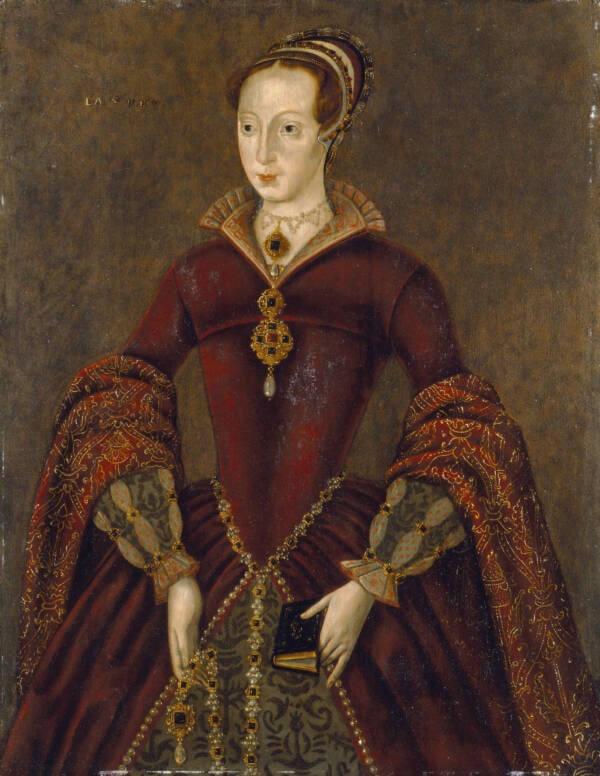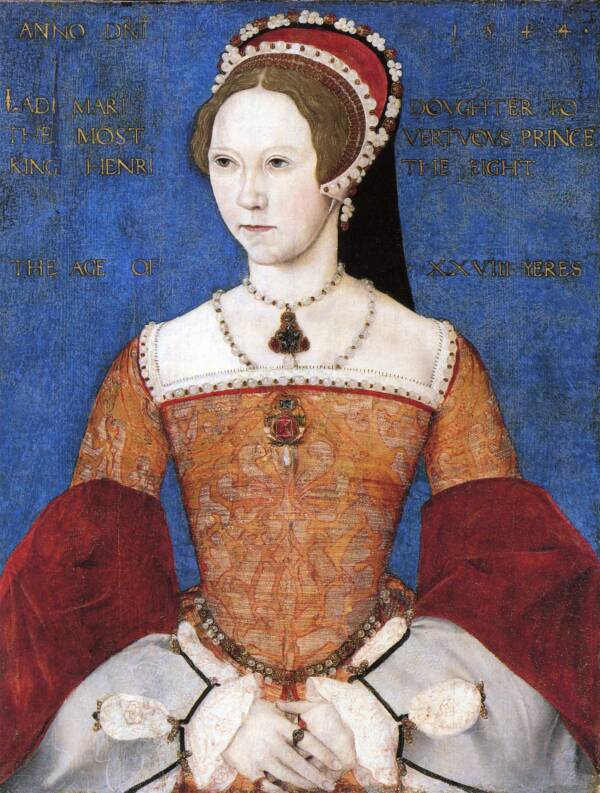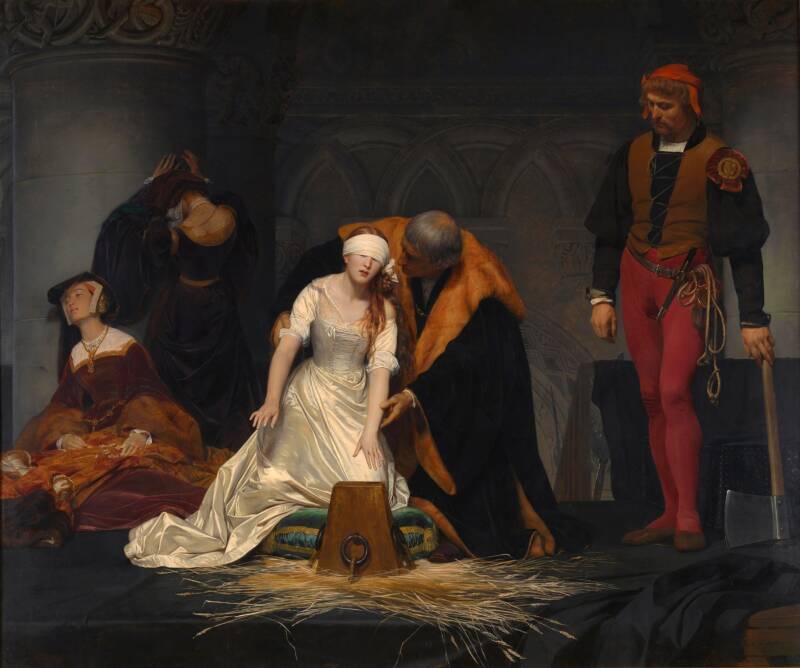Lady Jane Grey became queen upon the death of King Edward VI in July 1553, but quickly lost her throne to Mary I, the eldest daughter of King Henry VIII, nine days later.

Public DomainLady Jane Grey, the so-called Nine Days’ Queen.
Most know the story of Queen Mary I of England and of her half-sister Queen Elizabeth I of England. But fewer know about the queen who preceded them, Lady Jane Grey. Known as the “Nine-Days’ Queen,” Jane rose to power after the death of Edward VI — but only held it for nine days.
Something of a footnote to English history, Jane spent most of her short life as a pawn for the powerful men around her. She was related to King Henry VIII’s sister, and seen by some as a potential bride for his son, Edward VI.
When Edward died young, however, Jane was thrust onto the throne. Her ascension to power roused the ire of Henry’s eldest daughter, Mary, who quickly gained support for her own claim to the throne. Before long, Mary took power and Lady Jane Grey’s queenship ended after just nine days.
Less than a year later, Lady Jane Grey was beheaded at the age of 17.
The Early Life And Lineage Of Lady Jane Grey
Born around 1537, Lady Jane Grey had a privileged position in Tudor-era England. Her mother was the daughter of King Henry VIII’s sister, Mary, which made Jane a distant cousin to Henry’s children, Mary, Elizabeth, and Edward.

Public DomainLady Jane Grey was related to King Henry VIII through her mother, which made her a subject of great interest to many in the royal court.
Because of her royal lineage, Jane lived in comfort and received a good education. As Historic Royal Palaces notes, Jane studied several languages, including Greek, Latin, Hebrew, and Italian, and enjoyed reading philosophy.
Her connection to King Henry VIII also made her a subject of great interest to the power-hungry men around her. After Henry died in 1547 and Edward VI became king at the age of nine, a Council of Regency stepped in to help the new monarch rule. John Dudley emerged as the council’s leader, and he arranged to marry Jane to his son, Lord Guildford Dudley, in May 1553.
John Dudley likely saw the writing on the wall. He knew that Edward was sickly and could soon die. And Edward, who wanted his successor to be a male Protestant, disinherited his half-sisters Mary and Elizabeth as he grew seriously ill in June 1553. Instead, the king named his Protestant cousin, Lady Jane Grey, as his “devise.” He intended the crown to pass onto her sons or, if she had none, to her sisters’ sons.
Then, on July 6, 1553, King Edward VI died at the age of 15.
The ‘Nine-Days’ Queen’ Awaits Her Throne
Three days after Edward VI’s death, Lady Jane Grey was summoned to a secret meeting at her father-in-law’s home. There, Jane learned to her great shock that she was to be the next queen of England.
The new queen reportedly fainted.
“Declaring to them my insufficiency,” Jane later recalled of the moment she found out, “I greatly bewailed myself for the death of so noble a prince, and at the same time, turned myself to God, humbly praying and beseeching him, that if what was given to me was rightly and lawfully mine, his divine Majesty would grant me such grace and spirit that I might govern it to his glory and service and to the advantage of this realm.”

Public DomainA 19th-century painting depicting entitled “Lady Jane Grey Prevailed on to Accept the Crown.”
On July 10, Jane entered the Tower of London, where it was customary for new monarchs to await their coronation. But her coming coronation was not without controversy. Mary, Henry VIII’s eldest daughter, immediately wrote a letter to the Privy Council and pointed out that her father had made her — and not Jane — second in line for the throne after Edward VI.
“You know, the realm and the whole world knoweth,” Mary furiously wrote, according to Historic UK. “[T]he rolls and records appear by the authority of the King our said father, and that King our said brother, and the subjects of this realm; so that we verily trust there is no good true subject, that is, can, or would, pretend to be ignorant thereof.”
Mary wasn’t the only person who thought so. Others quickly came to her support and, on July 19, 1553, the Privy Council switched their support from Jane to Mary. For Lady Jane Grey, the Tower of London became a prison — and in August, Mary rode into London as the new queen.
The Execution Of Lady Jane Grey
In November 1553, Lady Jane Grey and her husband were found guilty of high treason and sentenced to death. But Mary, then Queen Mary I, was lenient with her cousin. She allowed them to keep their lives and remain as prisoners at the Tower of London. (Jane’s father-in-law was not so lucky — he was put to death for attempting to raise an army against Mary.)

Public DomainMany saw Mary, and not Jane, as the rightful heir to Henry VIII’s throne and Mary soon won more popular support.
However, the new queen faced challenges of her own. As the Catholic Mary prepared to marry the Catholic Philip II of Spain, a group of Protestants — including Jane’s father — rose up against the new queen. Though the rebels were swiftly quashed in February of 1554, their uprising highlighted the danger of letting Lady Jane Gray, the Nine Days’ Queen, live.
Mary offered Jane and her husband a choice — convert to Catholicism or die. But both Jane and Guildford refused. They were sentenced to death.
On Feb. 12, 1554, Guildford was executed first at around 10 a.m. Then Jane, dressed in black, was escorted onto a scaffold on Tower Green. Having given her things away to her mourning ladies-in-waiting, Jane affixed a blindfold around her eyes and asked her executioner to “despatch her quickly.”
But as Jane reached forward, she couldn’t find the executioner’s block. “What shall I do?” she cried as she blindly groped for the block. “Where is it?” Someone, likely the Deputy Lieutenant of the Tower, swooped down to help her in a poignant scene famously depicted in an 1883 oil painting by Paul Delaroche, “The Execution of Lady Jane Grey.”

Public Domain“The Execution of Lady Jane Grey” an oil painting by Paul Delaroche. 1883.
Then, Lady Jane Grey lay down her head for her execution. In one stroke of the blade, she was killed. Jane was around the age of 17 years old.
In the centuries following her death, Protestants came to see Jane as a martyr — especially in light of Mary I’s infamously cruel reign (Mary would later be referred to as “Bloody Mary” for her ruthless burning of Protestants). But Jane’s role in English history can be hard to pin down.
Was she merely a pawn of the power-hungry men around her? A tragic figure doomed to die for others’ actions? Or did Lady Jane Grey have more agency in than we know? From centuries away, it’s hard to know for certain.
Whatever the belief, Lady Jane Grey remains one of the most fascinating and tragic figures in English history. The “Nine Days’ Queen,” she’s most famous for her short-lived rule — and for her tragic death.
After reading about Lady Jane Grey, the so-called Nine Days’ Queen, discover the story of Elizabeth Bathory, the 17th-century countess allegedly responsible for the deaths of hundreds of young women. Then, read about some of the strangest royal deaths in history.





